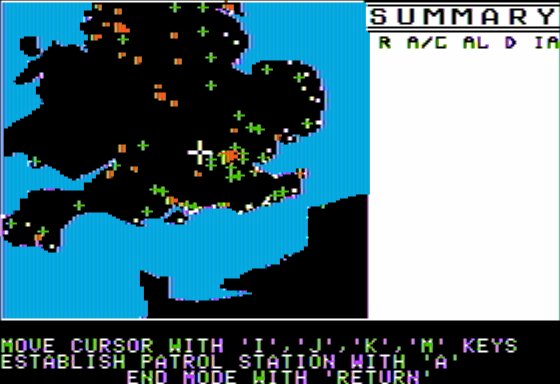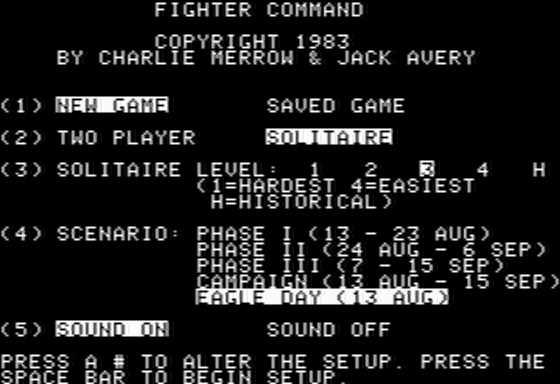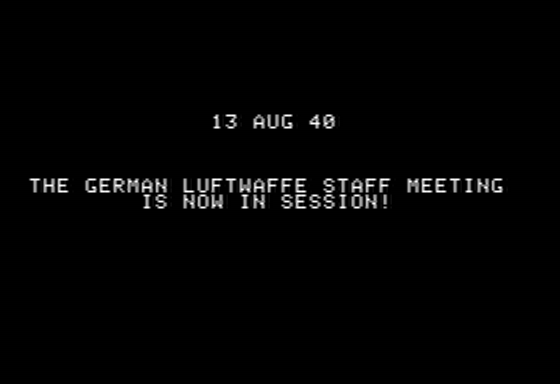Battle Of Britain
A superb simulation of the Battle of Britain, Fighter Command is without any doubt one of the very best of its type available.
The game comes with a large map of England, a German player aid card, a British player aid card and a set of diecut counters of the British squadrons that took part in the battle.
There are four scenarios and a campaign game which can be played on five levels of difficulty.

The first scenario, Phase I, covers the first week and a half of the battle. Phase II deals with the middle two weeks. Phase III runs through the last week of the battle and the fourth Eagle Day is an introduction to the game as it just covers that one day.
The campaign on the other hand covers the entire 34-day conflict in superb detail from August 13, 1940 - Eagle Day - through to September 15.
In a solo game, the micro takes on the role of Herman Goering and the Luftwaffe. But in a two-player game, the sequence of play would be German briefing, German orders, British briefing, British orders, British intercept phase, Computer overnight activity phase and finally victory determination.

During the German briefing phase the German player looks at a series of reports. The first is Yesterday's Operations which lists the number of aircraft and pilots lost and the number received as replacements. The second report, Intelligence, provides a summary of damaged targets considered to be out of action along with a guide to the estimated RAF strength. Both reports lie like mad. The third item is the Readiness report which gives a guide to the current strength of the three Luftlotten. The final part of this report takes a comprehensive look at the weather.
In the German orders phase the German player is asked if he wishes to launch raids. If the answer is No, the British player takes over. If Yes, the German is asked to select the target type - airfield, radar station or industrial centre. Then again he can send in a feint/sweep - the feint consists of bombers and fighters while the sweep is made up of fighters. After selecting the target type the player is asked to indicate primary and secondary targets.
Offset approach points for each raid may be selected plus the desired time of arrival over the target. An offset approach point can be used to fool the RAF into thinking the raid is going one way when it is in fact going to turn.

The bombers are selected by Gruppen and a listing of the strength, experience and morale of each individual gruppen is listed as you select them. The fighter escorts and escort mode are then added.
Having selected the forces, the last thing before moving onto the next is the height selection for the raid. German bombers may only operate once a day while fighters may operate twice as long as there is a four hour break between missions.
The British briefing phase is the same as the German one with Yesterdays Operations reporting total number of targets bombed, total number of raids and the number of friendly and enemy aircraft lost. The latter is exaggerated most of the time. The Intelligence report gives an estimate of German strength which can be taken with the usual pinch of salt. A Readiness report details every squadron in each of the four RAF groups and there is a Damage Summary which shows the level of current damage to cities, airfields and radar stations.

The first option in the British orders phase is Change Readiness and Tactics. Each of the four RAF groups may be put on runway alert, cockpit alert, hut alert, 30-minute alert or two-hour call. In addition, the British player sets up the tactics of the five aircraft types available to him - Spitfire, Hurricane, Defiant, Blenheim and Gladiator. The second option is Patrol Stations, of which up to ten may be placed almost anywhere. Patrols may not be placed too close to the French coast.
The third option is to change individual squadron or airfield status. The last part of the orders phase is the transfer of individual squadrons from one airfield to another. The British intercept phase is the heart of the game. As soon as the British player has finished his book-keeping, a map of Britain appears on the screen, to the right of which is an information window.
Here information on each raid appears as soon as it has been picked up by radar stations, patrol squadrons or the Observer Corps. A clock at the bottom of the screen cycles in 30 minute intervals until German aircraft being taking off from their bases. At which point the clock beings to cycle in two minute intervals. Although it gives the impression of being a real time simulation it is not - thankfully! Once the clock starts, the British player may interrupt the program. He may toggle between the Britain map and any one of three tactical maps.

Even though a raid may have been picked up by ground stations, finding it in the air may not be so easy. The size of the raid, the weather conditions and to some extent the morale of the RAF squadron will all have a bearing on the result.
During the Overnight Activity phase the computer works out the RAF replacements for each fighter type, depending on the damage to production centres and repairs damage to planes, airfields, radar stations and production centres.
It does the same for the German gruppen along with adding in replacements. In the Victory Determination phase the computer works out the total points gained by the Germans. Depending on the scenario, points are gained for each airfield and radar station out of action, damage to industry, aircraft losses, etc.

I don't think I would want to make any major changes to the overall format. However, I would like to add an option for the British player in that a recall order would be of some help. On occasion one or more squadrons have been sent up to chase a raid. In the meantime the raid has bombed its target, turned, and is halfway home with the squadrons still chasing it. You know they have no hope of catching up with it yet they continue the pointless chase until it disappears.
Against the computer, the game plays well, though on the easy levels the computer-controlled raids can be a little predictable, especially in good weather.
You can get through five or six days in a good evening against the computer. Against a human opponent it's a different story. One can find that raids come in at all times of the day in dribs and drabs to wear the RAF down and the British response to such a day can take up a good three hours or more, so I would never play this game face-to-face.
In a two player game I would not allow the German player to see the screen while I was doing my moves as the German could pick up intelligence he should not have, though I understand that some people play the game that way.
I prefer to play a human opponent... by post. Yes I did say by post! It's an ideal postal game thanks to the game save options. There are three save options, but the two that make it possible by post are located before and after the German player's bash. Being a postal board wargamer for many years it is a natural progression for me.
Well done SSI and in particular Charles Merrow and Jack Avery. Now, how about the air war over Europe, lads?


 1st March 1985
1st March 1985


